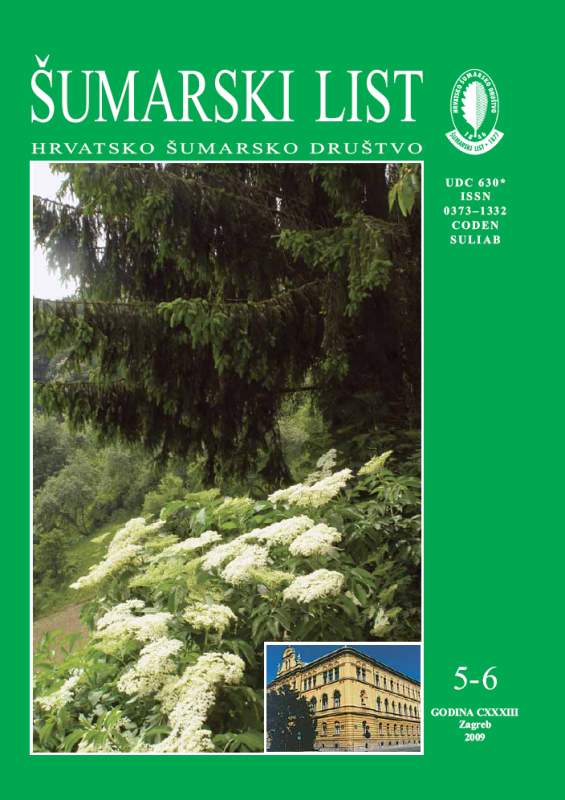| |
| RIJEČ GLAVNOGA UREDNIKA |
| |
|
|
| Branimir Prpić | |
| HOW TO SECURE THE FUTURE OF YOUNG, NATURALLY MANAGED FORESTS IN CROATIA DURING RECESSION
pdf
HR
EN
|
236 |
| |
| IZVORNI ZNANSTVENI ČLANCI |
| |
|
|
| Tikvić, I., Ž. Zečić, D. Ugarković, D. Posarić | UDK 630* 429 + 851 (001) |
| Damage of Forest Trees and Quality of Timber Assortmets of Pedunculate Oak on Spačva Area
pdf
HR
EN
|
237 |
| Trinajstić, I., Z. Cerovečki | UDK 630* 188 (001) |
| Festuco drymeiae-Fagetum Magic 1978 Association (Aremonio-Fagion) in the Vegetation of Northwest of Croatia
pdf
HR
EN
|
249 |
| Roth, V., T. Dubravac, I. Pilaš, S. Dekanić, Z. Brekalo | UDK 630* 232.3 (001) |
| Acorn Size of Pedunculate Oak (Quercus robur L.) and Sessile Oak (Quercus petraea Liebl.) as a Factor in Growth and Development of Seedlings
pdf
HR
EN
|
257 |
| Jakovljević, T., K. Berković, G. Tartari, B. Vrbek, J. Vorkapić-Furač | UDK 630* 425 (001) |
| Atmospheric Deposition in Forest Ecosystem of Europe and Research of New Methods for Determination of Phosphorus and Ammonia Within a Framework of ICP Forests
pdf
HR
EN
|
267 |
| Degmečić, D., K. Krapinec, T. Florijančić | UDK 630* 156 (001) |
| Factors that Determine Sex of Red Deer Calves (Cervus elaphus L.): Verification of Current Knowledge
pdf
HR
EN
|
279 |
| Potočić, N., I. Seletković, M. Čater, T. Ćosić, M. Šango, M. Vedriš | UDK 630* 232.3 + 422 |
| Ecophysiological Response of Sun-Exposed Common Beech (Fagus Sylvatica L.) Seedlings under Different Fertilization Levels
pdf
HR
EN
|
289 |
| Rosavec, R., D. Dominko, D. Barčić, D. Starešinić, Ž. Španjol, K. Biljaković, M. Ožura, N. Marković, D. Bognolo | UDK 630* 432.1 (001) |
| Analysis of Distribution of Areas Affected by Forest Fires on Island of Brač, Island of Korčula and Island of Rab
pdf
HR
EN
|
301 |
| |
| PRETHODNO PRIOPĆENJE |
| |
|
|
| Perić, S., J. Medak, I. Pilaš, B. Vrbek, M. Tijardović | UDK 630* 413 + 232 |
| Initial Research Results of the Possibility of Revitalizing Očura II Querry with Autochthonous Tree and Shrub Species
pdf
HR
EN
|
309 |
| |
| PREGLEDNI ČLANCI |
| |
|
|
| Konjević, D., U. Kierdorf, V. Njemirovskij, Z. Janicki, A. Slavica, K. Severin | UDK 630* 132 |
| Wild Boar Tusk Pathology: An Overview of the Current Knowledge and Models of Reparation
pdf
HR
EN
|
319 |
Summary: The wild boar (Sus scrofa L.) is an autochthonous game species in large parts of Europe. Their dental formula comprises 44 teeth resembling closely to the primitive full Eutherian formula. Wild boar tusks are continuously growing maxillar and mandibular canines of male boars. Their large size and the fact that they are protruding from the oral cavity makes them particularly prone to different traumatic impacts. However, due to their enormous defensive and growth potential, tusks can survive broad spectrum of pathological conditions. All mentioned together with the fact that wild boar tusks are preserved as trophies for longer time makes them extremely suitable for studying the dental pathologies. On the other hand, their value as trophies can be restrictive for application of invasive analytic tools. Therefore, we briefly introduce application of computed tomography as tool for virtual analysis. Up to now, a broad spectrum of wild boar tusk pathologies were reported in the literature, including complete and incomplete intra- and extra-alveolar fractures, early trauma to the developing tooth, creation of the duplicate growth zones, deposition of the dentinal bridges with consequent necrosis of the pulp proximal to the bridge, supernumerary teeth, deposition of tetracycline into hard dental tissues, etc. One mandibular tusk showed marked signs of resorption apically, suggesting a spread of the inflammation from the pulp into the periodontium. By reviewing the known models of the reparation of the teeth of limited growth and by comparing these models with continuously growing teeth, one can gain real insight about sources and potential of reparation of the wild boar tusks. The reparative potential of every tooth is composed from possibilities to reconstruct hard dental tissues, to separate infected from intact part and to resist bacterial invasion of the dental pulp. The continuously growing teeth poses potential to deposit not only dentine and cementum, but also their ameloblast at the apical part remains active during the whole life. The potential of tertiary dentine formation is significantly higher than in tooth of limited growth. Their wide conical pulp and large blood supply ensures constant presence of sufficient amounts of immune cells. And finally, recent findings of stem cells in the growth zone of rodent incisors implies on the possibility that stem cells could be present at the growth zone of wild boar tusks also. Their presence allows denovo formation of previously destructed odontoblasts and ameloblasts through the process of differentiation.
|
| |
| STRUČNI ČLANCI |
| |
|
|
| Frković, Alojzije | UDK 630* 156 |
| The First Hunting Textbook of Bosnia and Herzegovina
pdf
HR
EN
|
327 |



